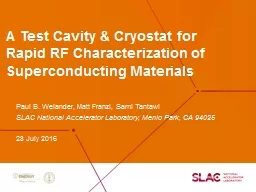

Rapid RF Characterization of Superconducting Materials Paul B Welander Matt Franzi Sami Tantawi SLAC National Accelerator Laboratory Menlo Park CA 94025 28 July 2016 Superconducting RF Materials ID: 911894
Download Presentation The PPT/PDF document "A Test Cavity & Cryostat for" is the property of its rightful owner. Permission is granted to download and print the materials on this web site for personal, non-commercial use only, and to display it on your personal computer provided you do not modify the materials and that you retain all copyright notices contained in the materials. By downloading content from our website, you accept the terms of this agreement.
Slide1
A Test Cavity & Cryostat for Rapid RF Characterization of Superconducting Materials
Paul B. Welander, Matt Franzi, Sami TantawiSLAC National Accelerator Laboratory, Menlo Park, CA 9402528 July 2016
Slide2Superconducting RF Materials
Collaborate w/ others
in DOE complex and
beyond to advance state of the art for SRF materials.Example: Temple MgB2RF measurement as tool for process developmentRecent measurements:MgB2 – Temple Univ., Peking Univ.Nitrides – Naval Res. Lab, MIT Lincoln LabNb – Alameda Applied Sciences, JLab
SRF Materials Development
Two hemispherical test cavities (one Nb, one Cu) to measure surface resistance & quenching field at 4 K.X-band operation (11.4 GHz) small sample size, 33% of cavity loss from sample surface.Closed-cycle, pulse-tube cryocooler enables 24-hr. test cycle unmatched throughput & rapid feedback.
2” dia. sample
Novel SRF Cavity Fabrication
Develop SRF coatings that can be applied to novel accelerator structures being designed and built at SLAC.
Optimize coatings & cavity design for:
High Efficiency – higher
Q
, lower dynamic loss, less cooling power requiredHigh Gradient – higher beam energyHigh Temperature – operation at 4 K
Optimize
Q
0
Slide3System Capabilities
SLAC test cavities and cryostat enable rapid (24-hr. cycle) characterization of superconducting RF (SRF) materials.Characterize surface impedance by measuring the quality factor, Q0,
of a
cavity
at
11.424 GHz, down to 4 K.Capable of low power (PNA) and high power (Klystron) measurements.Compact design thanks to X-band operation (5.6” diameter).Interchangeable flat cavity bottom, fits 2” (50.8 mm) diameter samples up to 0.25” (6.25 mm) thick.Cavity design maximizes H-field and minimizes E-field on the sample surface.Cu and Nb cavities allow us to measure surface resistance (Rs), quenching field (Hquench), and transition temperature (Tc).Can achieve Hpeak ~ 360 mT with 50 MW Klystron.
Slide4Cryomech Pulse-Tube Cryocooler
Our cavity cryostat utilizes a Cryomech cryorefrigerator.Two-stage pulse-tube operation
Base temperature of 3.5 K with cooling power of 1.35 W at 4.2 K
Utilize the remote motor version to minimize cavity vibrations.
First stage (40 K) used for thermal shielding and cold section of waveguide.
4
Slide5Cavity Cryostat Assembly – Model View
5
Cryocooler
2
nd
StageSampleUnderTestRF Feed40 K ShieldDiodeTempSensorsSamplePlateCavity Iris
Slide6Hemispherical Cavity Design – HFSS Modeling
High-
Q
hemispheric cavity with a TE
032
-like mode at 11.4 GHzMaximum H-field (2.5x Hdome), zero E-field on sampleSample accounts for 8% of cavity area, but 33% of cavity lossNo radial current on the cavity bottomr = 0.95”RF Feed
Slide7Sample Surface
Hemisphere Surface
f
0
= 11.4 GHz
Qtotal = 1.6e7Gtotal = 1416 ΩGNb = 2120 ΩGsample = 4264 ΩNb-Coated Cavity Design
Slide8Two Cavities8
Coated w/ 5
μ
m
Nb
film at CERN (S. Calatroni)
Slide9Cavity Assembly
Sample
Under
Test
Sample
PlateCavity IrisRF Feed40 K Shield
Slide10System Photo and RF Measurement Network
Cryostat
Waveguide to Klystron/NWA
Measurement ports:
Forward Power: 5 (and 2)
Reflected power: 4(Waveform measured by either a peak power meter or a scope with mixers)Low-power PNA measurement: 3 (or 6)
1
234CavityKlystron10dB45dB45dB
5
6
55dB
7
Cryostat
Mode converter
BendLoadSystem Diagram
Slide11Bulk Nb Reference Sample
Single-crystal bulk Nb from DESYReceived January 2008
Baked in 2010, untreated since
Q
0
in Cu limited by cavity materialsIn Nb cavity at 4 K, Q0 translates to Rs = 65 μΩAssumes Rs,sample = Rs,cavityStandard deviation of 1%Assuming f 2 and (T/Tc)4 dependence, Rs = 47 nΩ at 2.0 K and 1.3 GHz11Q0 vs T for Nb Referencein both Nb & Cu cavities
Slide12Nb Films from AASC & JLab
12
Low power measurements in our
Nb
cavity.
Nb films on copper (JLab, A.-M. Valente-Feliciano) & stainless steel (AASC, K. Velas) compare favorably with our bulk Nb sample.Assuming a cavity Rs of 65 μΩ, both films have Rs of about 17 μΩ.
Slide13MgB2 on Copper from Temple Univ.
13
Series of MgB
2
films grown on copper last summer at Temple Univ. (W.
Withanage, X. Xi).Q0 measurements served as feed-back to develop growth process, enabling rapid improvement.Tc’s up to 38 K were measured in Cu cavity.
Slide14MgB
2 on Niobium from Peking Univ.
14
Recently measured two MgB
2
films grown on niobium at Peking Univ. (Z. Ni, K. Liu).Process improvement over past eight months, reducing Rs ~ 1 OM
Slide15Cavity Cryostat Status & Summary
Cu and Nb cavities allow us to measure surface resistance (Rs), quenching field (
H
quench
), and transition temperature (
Tc).Low-power Q vs. T takes less than 24 hrs. rapid feedback for film growth process development.Currently building up capability to perform high-power testing, and measure Hquench.Built in concurrent capability to measure samples at low power in both cavities.
Slide1616Highly Efficient Direct-Feed Split-Cell Cavity
Z. Li & S. Tantawi
Slide17Demonstration in Cu at X-band
20-cell X-band structure fed by two waveguides from a single RF input.Bead-pull measurement shows uniform field dist.Currently under test, has exhibited up to 130 MV/m.
17
Slide18Adapting for SRF
Direct-feed cavity utilizes highly reentrant cell shape, shifting max-H from equator.
RF cavity loss reduced by nearly 60% c.f. TESLA.
18
1.3
GHz TESLA1.3 GHz direct feedR/Q (ohm/m)984.02571.4Esurf/Eacc2.025.32Bsurf/Eacc (mT/(MV/m))4.174.04Ploss (W/m/(MV/m)0.1010.043Q01e100.91e10
Slide19Tuning Isolated Cells19
Tuning Isolated Cells
Plunger w/ zero offset from the coaxial center
Slide2020An Efficient SRF Split-Cell Cavity
Challenge # 1 is how to fabricate:Complicated structure precludes PVD – only vapor-phase dep seems plausible.
Cu structures are brazed. SRF cavity to be welded or bolted.
Accelerating mode has no azimuthal current, but excitation of HOMs and a
lossy
joint could kill efficiency.Current plan is to fabricate a 2-cell S-band structure from bulk Nb:Measure low-power Q Demonstrate tuning